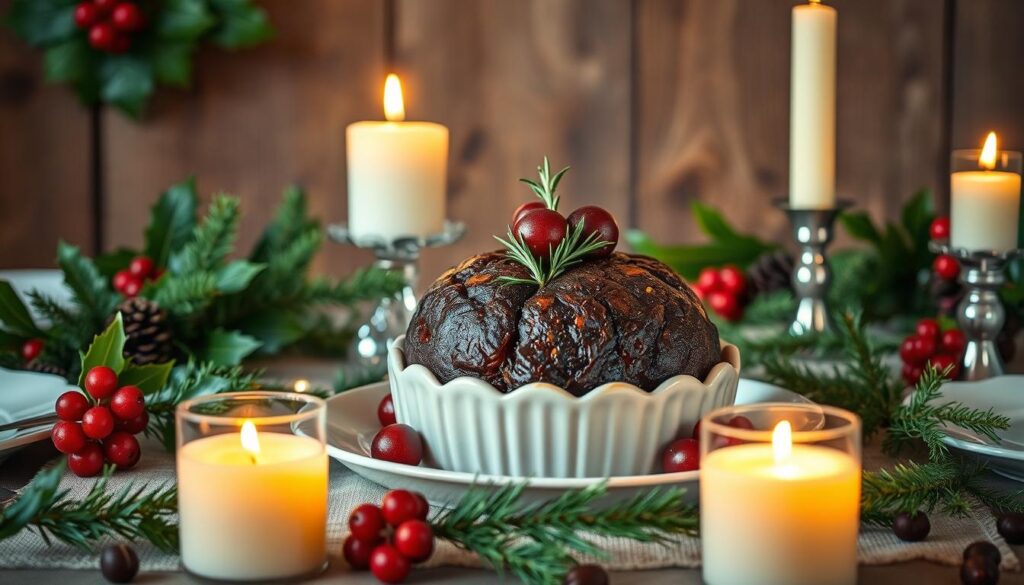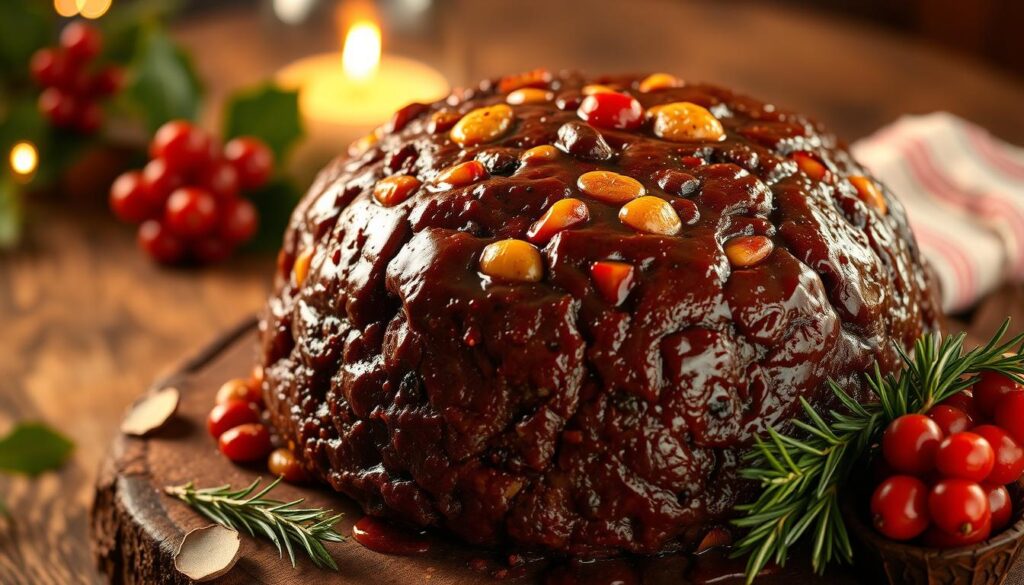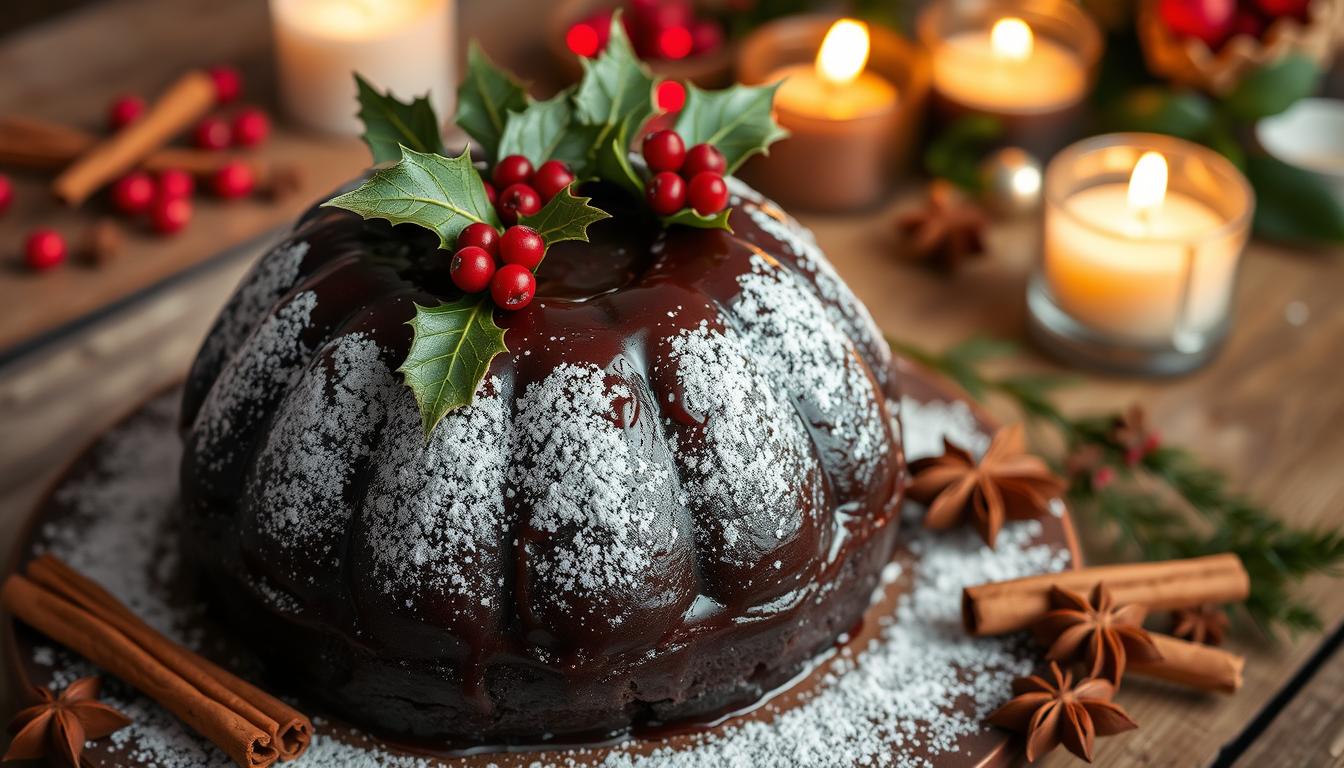As the holidays near, the smell of steaming Christmas pudding fills the air. It brings back memories of warm family times and special traditions. This classic British dessert is loved for its rich flavors and beautiful look. It’s a key part of holiday celebrations for many. It’s sure to delight your family and friends.
Key Takeaways
- Uncover the rich history and tradition behind the beloved Christmas pudding.
- Master the art of selecting and preparing the perfect blend of dried fruits.
- Discover the secrets to achieving the perfect texture and moisture balance.
- Learn the proper techniques for steaming and flambéing your Christmas pudding.
- Explore the timeless accompaniments and serving suggestions that will elevate your dessert.
The Rich History of Traditional Christmas Pudding
The Christmas pudding’s roots go back to medieval England in the 14th century. It started as a savory dish called “frumenty,” made with wheat, milk, cinnamon, and saffron. Over time, it became sweeter with eggs, breadcrumbs, dried fruits, and beer.
In the Victorian era, especially during Queen Victoria’s reign, the pudding became more popular. These puddings were rich, with suet, breadcrumbs, dried fruits, spices, and alcohol. They were often made weeks or months before Christmas.
Charles Dickens’ “A Christmas Carol” is famous for its description of the Christmas pudding. Dickens’ vivid words helped make the pudding a holiday tradition.
The British Empire’s growth made luxury ingredients like cane sugar and exotic spices more available. By the mid-18th century, the Christmas pudding was a big treat for families in the UK.
“Stir-Up Sunday,” the last Sunday before Advent, is a tradition tied to the Christmas pudding. Families would stir the pudding, making wishes for the year ahead.
Even though the pudding’s popularity has changed, there’s a growing interest in keeping this tradition alive. Modern chefs and home cooks are making their own versions, mixing old recipes with new ideas.
“Christmas is not Christmas till you’ve had plum pudding.” – Samuel Clemens (Mark Twain)
Essential Ingredients for Perfect Christmas Pudding
Making the perfect Christmas pudding is all about choosing the right ingredients. Dried fruits like raisins, sultanas, and currants are at the core. They soak in liquor like brandy or whiskey to add extra flavor.
The batter is a mix of suet or butter, brown sugar, breadcrumbs, flour, eggs, and mixed spice. This spice blend includes cinnamon, ginger, nutmeg, and coriander. Some recipes also add grated apple for moisture and texture.
| Key Ingredients | Quantity |
|---|---|
| Dried Fruits (Raisins, Sultanas, Currants) | 750g |
| Suet or Grated Frozen Butter | 150g |
| Brown Sugar | 175g |
| Breadcrumbs | 100g |
| Flour | 100g |
| Eggs | 3 |
| Mixed Spice | 2 tsp |
| Grated Apple (optional) | 1 |
| Brandy or Whiskey | 150ml |
With these ingredients, you’re set to make a Christmas pudding that will impress everyone. The secret to success is finding the perfect balance. You want the flavors to be rich and the spices to warm your heart.
The Art of Fruit Selection and Preparation
Making the perfect Christmas pudding begins with picking and preparing dried fruits. These fruits are the pudding’s heart, adding rich flavors. Choosing and preparing the fruits is key to a great pudding.
Choosing and Soaking Dried Fruits
Start by picking top-quality dried fruits like currants, sultanas, prunes, and candied peel. The right mix of fruits and batter is essential for taste and texture. Soak the fruits in brandy, rum, or Pedro Ximénez sherry for a few hours or days. This makes them plump and flavorful.
Proper Fruit-to-Batter Ratio
Finding the right balance between fruits and batter is crucial. A good mix is about 1 pound of fruits to 110 grams of breadcrumbs and 55 grams of flour. You can adjust this to get your perfect pudding.
Alcohol Selection for Soaking
The alcohol you soak the fruits in affects the pudding’s taste. Brandy or rum are common choices, but Pedro Ximénez sherry adds a sweet touch. Vodka is a good option for a lighter flavor, keeping the pudding moist without overpowering it.
“The key to a truly exceptional Christmas pudding lies in the careful selection and preparation of the dried fruits. Take the time to soak them in the perfect alcohol, and you’ll be rewarded with a delightfully moist and flavorful dessert.”
Christmas Pudding: Mastering the Basic Recipe
Making the perfect Christmas pudding is a cherished tradition. It’s all about mastering the basic recipe with rich, flavorful ingredients. This guide will help you make the best Christmas pudding, whether you’re experienced or new to baking.
The traditional recipe includes soaked dried fruits, flour, breadcrumbs, suet or butter, sugar, eggs, and spices. Start by soaking raisins, currants, and candied orange peel in brandy or rum for 24 hours. This step makes the fruits plump and flavorful.
After soaking the fruits, mix the rest of the ingredients. In a big bowl, whisk together flour, breadcrumbs, sugar, spices, and a pinch of salt. Then, gently add the soaked fruit, suet or butter, eggs, and a bit of spirit. Make sure everything is well mixed.
- Grease a 6-cup glass or ceramic pudding basin with butter or non-stick spray.
- Spoon the pudding mixture into the basin and press it down gently.
- Cover the basin with parchment paper and aluminum foil, then tie with kitchen string.
- Steam the pudding for 5 hours, adding water as needed.
- Let the pudding cool completely before unwrapping it.
The last step is curing the pudding. After it cools, poke holes in it and “feed” it with brandy or spirit once a week. This adds more flavor and moisture, making the pudding rich and indulgent.
“The best Christmas puddings are the ones that have been carefully crafted and allowed to mature over time, developing their complex flavors and velvety texture.”
Follow these steps to make a Christmas pudding that will impress everyone. The secret is using high-quality ingredients, paying attention to detail, and letting it mature. Enjoy the journey and the delicious outcome!

Steaming Techniques and Timing Secrets
Creating the perfect Christmas pudding is more than just a recipe. It’s about mastering the steaming process. Whether you use traditional methods or modern appliances, the right steaming technique is key. It affects the pudding’s texture and flavor.
Traditional Steaming Methods
The classic way to steam Christmas pudding is to place it in a large pot of boiling water. Let it simmer for 5-8 hours. This slow cooking lets the flavors blend perfectly. Make sure to wrap the pudding basin in a calico cloth to avoid water seepage.
Modern Appliance Adaptations
For those short on time, using a pressure cooker or Instant Pot can be a game-changer. These methods can steam your pudding in just 1-2 hours. They’re perfect for busy families.
Troubleshooting Common Steaming Issues
Steaming puddings can sometimes dry out. To avoid this, check the water level often and add more as needed. Some recipes suggest a two-step steaming process. This keeps the pudding moist and full of flavor.
| Steaming Method | Cooking Time | Advantages | Potential Issues |
|---|---|---|---|
| Traditional Pot Steaming | 5-8 hours | Allows flavors to fully develop | Requires more hands-on attention |
| Pressure Cooker/Instant Pot | 1-2 hours | Significantly faster cooking time | Risk of pudding drying out if not monitored |
By learning about steaming techniques and solving common problems, you’ll make a Christmas pudding that everyone will love. It’s a delight that will wow your family and friends.
The Perfect Texture and Moisture Balance
Making the perfect moist christmas pudding is all about mixing dry and wet ingredients just right. Suet, a traditional fat, is key for a rich, luscious feel in your mouth.
Some recipes add grated apple or carrots for extra moisture. Steaming is vital to get the right texture. If it’s overcooked, it can be dry and crumbly. If it’s undercooked, it’s too wet and dense.
The best moist christmas pudding is dark, sticky, and moist. It should hold its shape when you slice it. This perfect balance comes from the right mix of ingredients and steaming skills.
| Ingredient | Function |
|---|---|
| Suet | Contributes to a rich, moist texture |
| Grated Apple or Carrots | Adds extra moisture to the batter |
| Steaming Process | Crucial for developing the right consistency |

Getting the perfect suet pudding texture is an art. It needs a good understanding of how to mix ingredients and cook them. By balancing dry and wet parts and mastering steaming, you can make a Christmas pudding that’s moist, tasty, and can’t be resisted.
Traditional Accompaniments and Serving Suggestions
Serving the perfect Christmas pudding needs the right accompaniments. Brandy butter and custard are classic choices. They match the pudding’s rich, dense texture perfectly.
Classic Brandy Butter and Custard
Brandy butter is a must. It’s made from softened butter, powdered sugar, brown sugar, and brandy. This creamy, boozy sauce balances the pudding’s warmth.
For the best taste, mix 1 stick of salted butter, 2/3 cup powdered sugar, 1/3 cup brown sugar, and 3 tablespoons of brandy.
A rich brandy custard adds creaminess. It’s made with eggs, cream, sugar, and brandy. Heat it gently until it thickens.
The Art of Flambéing
Flambéing the pudding is a showstopper. Pour warmed brandy or vodka over it and light it. This adds flavor and drama.
Other options include vanilla ice cream or frying leftover slices in butter. These offer unique spins on the traditional.
The key is to let the Christmas pudding be the star. Choose accompaniments that enhance its flavors, balancing sweetness and booziness.
Storage Tips and Aging Process
The secret to the best Christmas pudding is in the aging process. Making your pudding weeks or months in advance is key. This lets the flavors mix and get richer over time. After steaming, cool the pudding fully. Then, wrap it tightly in fresh parchment paper and aluminum foil.
This keeps the pudding moist and prevents it from drying out. Store your pudding in a cool, dry place like a pantry or cupboard. Some recipes suggest adding more alcohol every few weeks. This boosts the flavor and keeps the pudding moist.
The alcohol in the pudding acts as a natural preservative. It makes the pudding safe to eat up to two years after making it.
If stored right, your Christmas pudding can last a long time. Traditional puddings with dried fruits, sugar, and alcohol can stay fresh for up to two years. Puddings with fresh fruit, however, last about 6 months to a year. Watch for signs of spoilage like bad smells or mold before enjoying your pudding.
| Ingredient | Shelf Life |
|---|---|
| Dried Fruit Christmas Pudding | Up to 2 years |
| Fresh Fruit Christmas Pudding | 6 months to 1 year |
With the right storage and aging, your homemade Christmas pudding can be enjoyed for years. Follow these tips to make the best Christmas pudding ever.
Proper Storage and Reheating Methods
Keeping your homemade Christmas pudding fresh is key. Store it in a cool, dry spot like a pantry or cellar. If you made it early, you can refrigerate it for three months or freeze it for a year.
There are ways to reheat your pudding. Steaming it for an hour is traditional and keeps it moist. Or, you can use the microwave for quicker heating, about 1-2 minutes on medium.
Leftover pudding can stay in the fridge for two weeks or in the freezer for three months. Some like it cold, others warm. For a special treat, fry it in butter and serve with ice cream. Reheating right is important to keep it moist and tasty.

